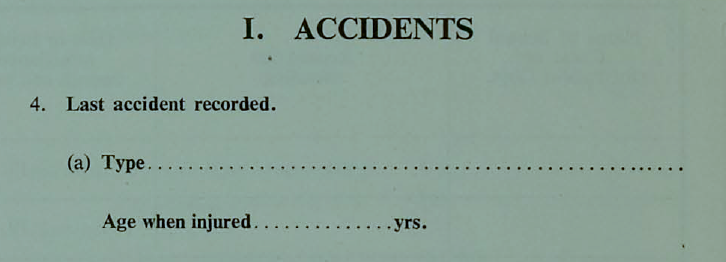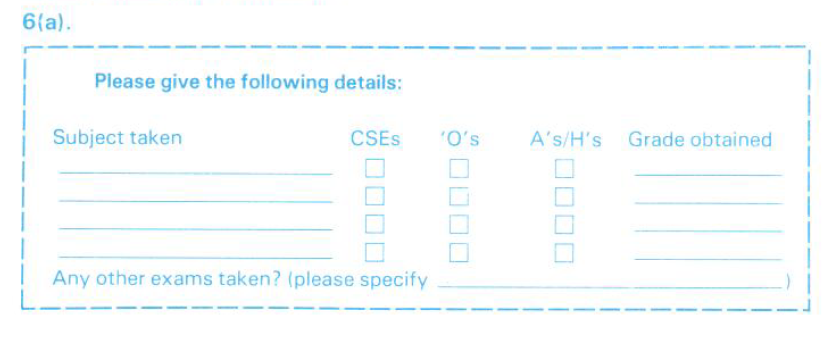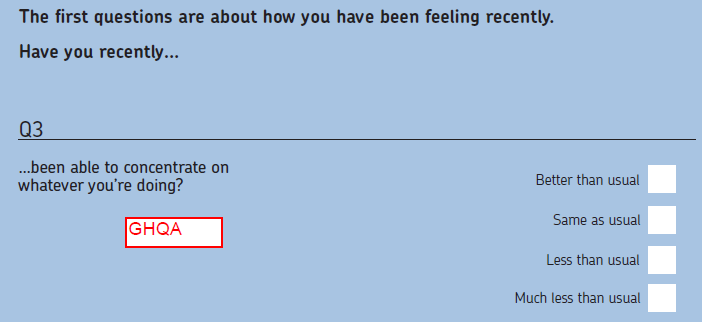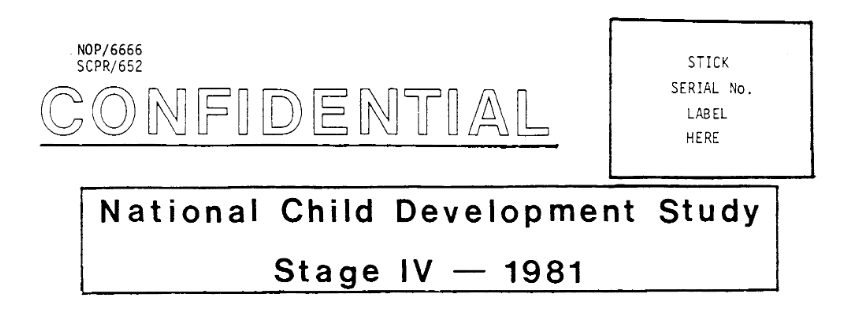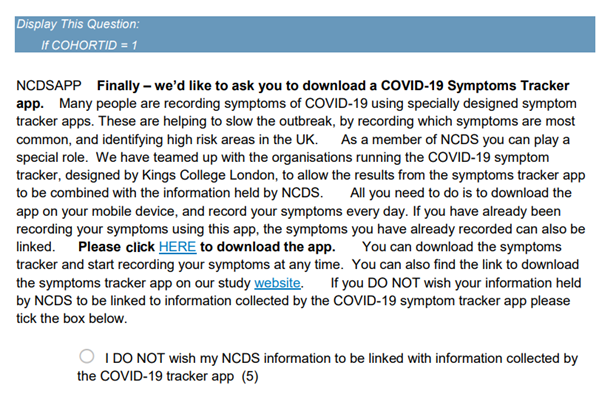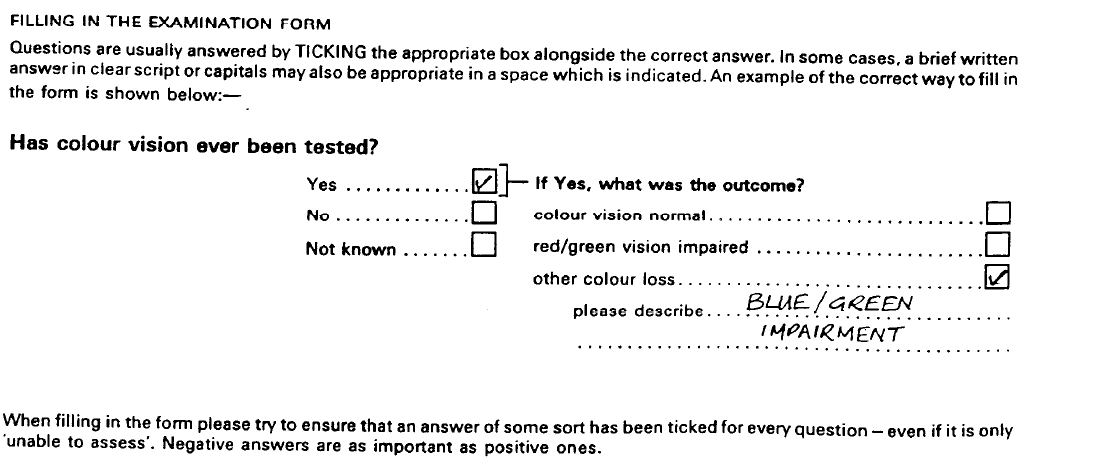This page is still under construction.
Contents
- Ellipsis (...)
- Date Masks
- Office Use Only text
- URL links
- Punctuation
- ASCII characters
- Contents page
- Examples
This page contains general information relevant to the entire questionnaire entry process. The topics discussed on this page are listed above.
Ellipsis (...)
The use of ellipsis in metadata archiving is varied but generally consistent. It involves the use of three dots to fill in a space or connect two parts of a question; the practice is to always add only three dots, regardless of the size of the space shown in the questionnaire. The following are examples of the different ways ellipsis is used in questionnaires and how they are entered into Archivist.
Sometimes a question contains ellipsis somewhere in between the question text; therefore creating a break in continuous text. This ellipsis needs to be entered into Archivist to show the intended location for the response domain attached to the question item (Example 1).
Example 1 Questionnaire: NSHD Interview School Nurse's Interview with Mother
Questionnaire layout:
Archivist view (nshd_54_iwm):
Note: Not all sequences of dots are entered into Archivist. For example, some questionnaires have dots between categories and their code values. This is generally done for the purpose of linking categories with their relevant code values due to a large space between them.
There are also scenarios where ellipsis is used both in between the question text and then directly at the end of it. In this case only the ellipsis used in between the question is entered into Archivist and not the ellipsis which comes after the question text (Example 2). This is because generally the response domain comes after the question text so this does not need to be specified using the ellipsis included in the questionnaire.
Example 2 Questionnaire: NCDS Stage IV 1981
Questionnaire layout:
Archivist view (ncds_81_i):
If, however, the ellipsis at the end of the question text is enclosed within brackets then it is entered into Archivist (Example 3).
Example 3 Questionnaire: BCS Life and Leisure Student Self-Completion Questionnaire 1986
Archivist view (bcs_86_lal):
Sometimes the question text is broken not only by spaces but by ellipsis also. Where an ellipsis appears at the end of the first part of the question and at the beginning of the second part of the question then this is entered into Archivist; when the text is concatenated and seperated by a space in between (Example 4).
Example 4 Questionnaire: USoc US1 Adult Self-Completion 2008
Archivist view (us1_asc):
This is also true for Question grids which sometimes have ellipsis within the code list(s) and/or questions. Example 5 below shows a question where the sub-questions on the y-axis include the ellipsis used in the questionnaire:
Example 5 Questionnaire: USoc US1 Adult Self-Completion 2009
Questionnaire layout:
Archivist view (us1_asc):
Date and Time Masks
Date masks are often used in questionnaires but are left out from Archivist, as shown in Example 6 below:
Example 6 Questionnaire: NCDS Parental Questionnaire 1974
Questionnaire layout:
Archivist view (ncds_74_pq):
Office Use Only Text
Not all of what is included in questionnaires is entered into Archivist. For example, information that is relevant for office use only, is excluded. There are different types of office use only information, for example, in ALSPAC questionnaires there is sometimes a space for filling in the questionnaire number (Example 7 and Example 8).
Example 7 Questionnaire: ALSPAC Mother/Daughter Growing and Changing (5)
Questionnaire layout:
Example 8 Questionnaire: NCDS 4 Interview 1981
Questionnaire layout:
URL links
Key considerations:
Should be added where the link would be clicked.
If this makes the text too difficult to read, this should be avoided.
As more and more questionnaires are available only online, they tend to provide embedded URLs attached to the questionnaire text. The embedded text should be added where the link would be clicked, adding brackets around the URL.
Example 9 Questionnaire: UCL - COVID-19 Wave 1
Questionnaire layout:
Archivist view (ncds_covid_q1):
Example 10 Questionnaire: UCL - COVID-19 Wave 1
Questionnaire layout:
Archivist view (ncds_covid_q1):
Punctuation
Sometimes additional punctuation or signs need to be entered into Archivist. As shown in Example 8 below, where the long line in between 'since then' and 'since you left school' has been entered using a forward slash to reflect the choice between the two sentence options.
Example 11 Questionnaire: NSHD Final Year 1966
Questionnaire layout:
Archivist view (nshd_66_fyc):
There are occasions when questions include punctuation or signs which are not entered into Archivist. For example, in older questionnaires it not unusual to find hyphens where there is a word break due to formatting. In these cases we ignore the hyphen and exclude it from Archivist (Example 12).
Example 12 Questionnaire: NSHD School Doctor 1961
Questionnaire layout:
Archivist layout (nshd_61_sd):
ASCII characters
There are some characters used in questionnaires which when being entered into Archivist, require a specific code known as ASCII characters. For example, the pound sign '£' needs to be entered as £. Another example of this is when entering the degree symbol for which the ASCII code is °. The only codes needed for Archivist entry are those that are over 127, some of which are provided below:
| Number | Character | Code |
|---|---|---|
| 134 | † | † |
| 149 | • | • |
| 169 | © | © |
| 174 | ® | ® |
| 164 | ¤ | ¤ |
| 233 | é | é |
| 209 | Ñ | Ñ |
| 163 | £ | £ |
Contents page
Sometimes a larger questionnaire may contain a contents page (see Example 13 below). However, since we do not document page numbers, and the headings will be included (most likely as sequences) elsewhere in the questionnaire, there is no benefit of including these in the metadata, therefore they can be excluded from the documentation.
Example 13 Questionnaire: ALSPAC Focusing on You
Questionnaire layout:
Examples
Sometimes there may be examples at the beginning of a questionnaire which show how to complete a questionnaire (see example 14 below). However, we do not include these examples here is no benefit of including these in the metadata without the images (which we cannot add), therefore they can be excluded from the documentation.If the examples make sense without the image then the text can be added.
Example 14 Questionnaire: BCS1980 Medical Exam
Questionnaire layout:
Archivist layout (bcs_80_me):
